DO YOU KNOW THE TRAVEL IN YOUR CHARACTERISTICS?
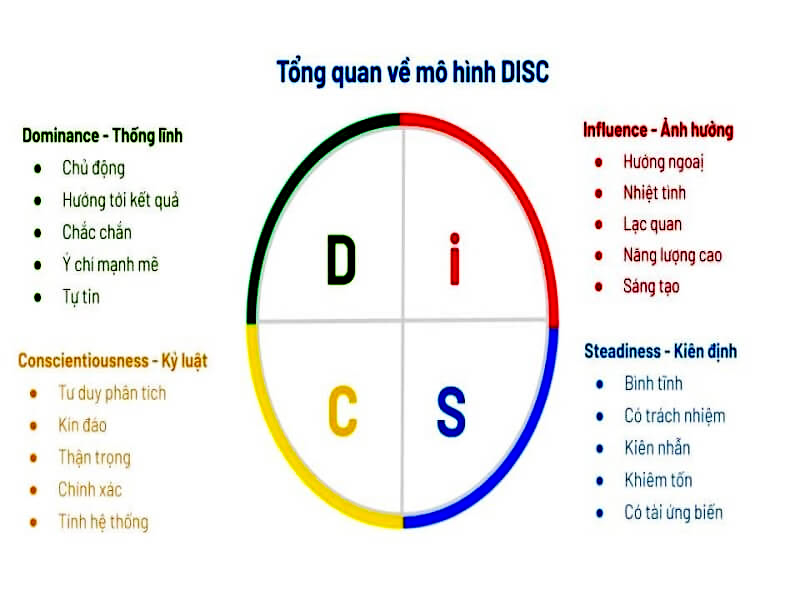
- DISC, WHICH GROUP DO YOU BELONG TO AND WHICH GROUP YOUR PERSONNEL BELONG TO WILL BE ALL HERE.
Determine immediately with DISC Test – The leading test of understanding human heart
Related services:
» Specializing in investment, purchase and sale of businesses, transfer of projects, investment consulting, business agents.
» Accounting and Auditing Services
» Corporate Law Services
» Real Estate MVA Land
» Setting up a business with a super preferential package
Widely applied in the fields of human resource management, recruitment, working environment or even personal life, employers can determine the personality and potential of candidates for the job. and individuals can also promote their strengths on the career path and apply DISC to read the opposite person.
We often come across people with opposite personalities at work: shy and timid as opposed to strong and dominant. But there are also people who are a combination of many personality traits, who appear repressive in one situation but become flexible and submissive in another. These can all be answered through the DISC model and 4 typical personality groups.
What is DISC?
DISC stands for 4 personality groups: Dominance – Influence – Steadiness – Compliance.
The DISC test is a type of test used to assess individual behavior that focuses on four personality traits that stand out in a given time period: Dominance (D), Influence (I), Consistency (S), and Compliance (C). This theory was later developed into a behavioral assessment tool by psychologist Walter Vernon Clarke. Based on these personality groups, we can apply them in communication to know the personality of the opposite person through observing their behavior, thereby creating effective communication and making the conversation easier. Be comfortable and not too awkward.
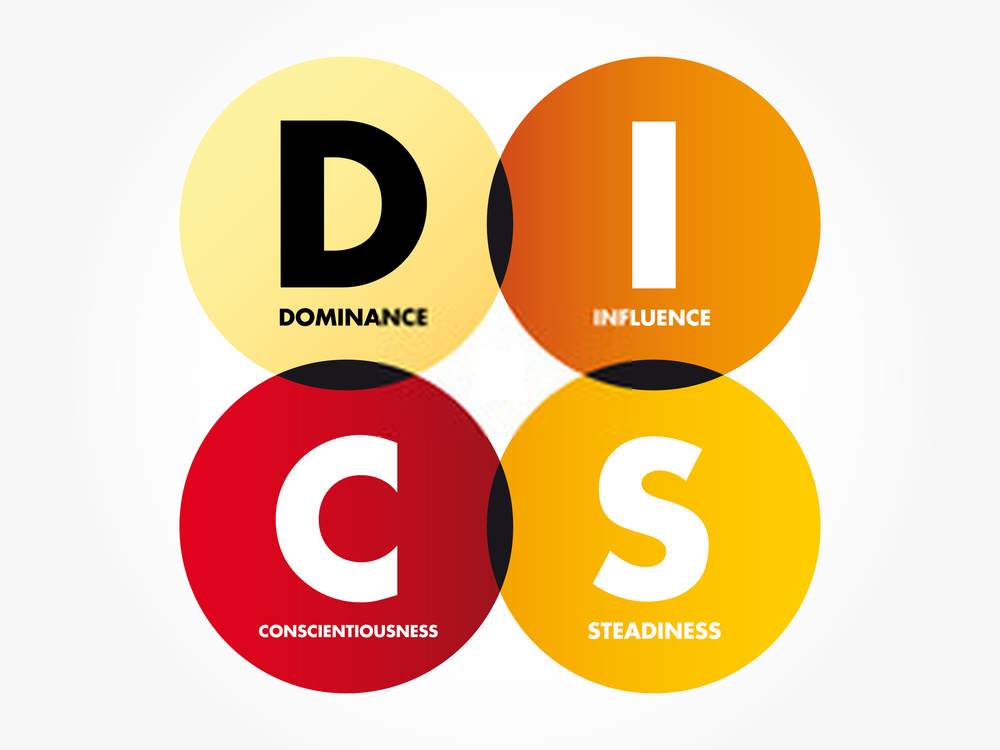
The DISC test is one of the most useful tools used by companies and organizations today. The evaluator will complete a questionnaire consisting of 24 to 28 questions. Each question includes four adjectives taken from Marston’s original research. By understanding the predictability of human communication and behavior, employers can better understand their employees and direct them to potential environments where they can maximize their potential. self.
Origin of DISC
The DISC test is built on the DISC theory of psychologist William Moulton Marston – also known as Charles Moulton. Marston is a lawyer and a psychologist. He was educated at Harvard University, graduated Phi Beta Kappa and received his BA in 1915, his LLB law degree in 1918 and his PhD in Psychology in 1921. After teaching at American University in Washington , D.C. and Tufts University in Medford, Massachusetts, in 1929 Marston moved to Universal Studios in California and began working as a Director of Public Service.

In addition to being the author of numerous self-help books, he and his wife, Elizabeth Holloway Marston, also inspired the creation of the character Wonder Woman. Marston’s greatest contribution to psychology was the creation of an identification of the emotions and behaviors of typical personality groups. After conducting research on human emotions, Marston published his findings in his 1928 book Emotions of Normal People, in which he explained that people express their emotions through four types of behavior: Dominance (D), Influence (I), Consistency (S), and Compliance (C).
He argues that these types of behaviors come from people’s sense of self and their interactions with their surroundings. Marston also proposed two dimensions that influence human emotional behavior. The first is whether a person perceives his environment as favorable or unfavorable. The second is whether a person perceives that he has control or lack of control over his environment.
Although Marston contributed to the creation of the DISC test, he is not the official creator of the test. In 1956, Walter Clarke, a psychologist, built the DISC test based on Marston’s DISC model theory. He did this by presenting the Activity Vector Analysis table – a list of adjectives that were given to ask people to point out which words best describe themselves. This assessment was created to be of use in cases where businesses need assistance in selecting qualified staff.

In 1965, Merenda, Peter F., and Clarke published their group’s discovery of a new tool in the “Journal of Clinical Psychology.” Instead of using a checklist, this “Self-Describing” test forces respondents to choose between two or more options. The factor analysis of this assessment was added to support the DISC. “Self-describing” was used by John Geier to create the original Personal Profile System in the 1970s.
DISC is used to determine how an individual reacts/acts when faced with problems at work or in how they solve problems.
The DISC model of human behavior is based on two basic observations about how people generally behave
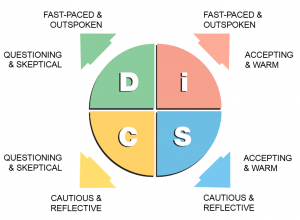
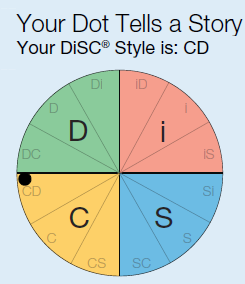
Observation #1: Some people are more “open” while others are “reserved”.
You can think of this trait as the “inner motivation” or “speed” of each person. Some people always seem to be ready to “go” and “get on with something” quickly. They start their engines quickly. Others tend to start more slowly or with more caution.
Observation #2: Some people have a penchant for “rule of law,” while others have a bias toward “human rule.”
You can think of this trait as an external focus, or the external priorities that drive them. Some people focus on getting things done (tasks); others are more sympathetic to those around them and their feelings.
DISC . personality groups
4 main DISC personality groups
Also from the above four personality traits, the DISC test gives four specific groups of people, including Leaders (group D), Influencers (group I), Consistency (group D). Group S) and Group of Compliance (Group C).
Each individual has all four personality groups above, to varying degrees. When we read an individual’s DISC chart, we pick one or two groups that account for the highest percentage to determine that person’s typical personality.
Dominance
The people in this group are important to the completed results. They are always confident and motivated to compete to win or achieve success. They always accept challenges and act immediately to achieve results. Leaders are often described as strong, confident, agile, always approaching problems directly. However, the minus point of people in the Leader group is that they are sometimes limited by indifference to others, impatience and skepticism. They are also sometimes said to be vulnerable.

Goals of the Leaders Group:
- Achieve excellent goals.
- Independence.
- Aim for new opportunities.
- Control the opponents.
However, they will have difficulty having to:
- Show patience.
- Working with details.
When communicating with Leaders, you should show them your end goal, keep your explanations short, don’t repeat, avoid off-center talk, and focus on solutions instead of problems.
The Leaders are usually: Developer, Development Orientation, Inspirator, Creative Worker.
Group of Influencers (Influence):
People in this group focus on influencing or persuading others with their openness and relationships. They are often described as persuasive, enthusiastic, warm-hearted, optimistic and have faith in others. Their working style always shows cooperation and enthusiasm. Influencers are often motivated by social recognition (or a group of people in society), group activities, and relationship development. Because of this, they will be afraid of losing influence, being rejected or being ignored.
Influencers can be limited by being impulsive or disorganized.

The Goals of the Influencer Group:
- Achieve victory with flair.
- Have good friendships and always feel happy.
- Gain prestige in the community or gain popularity.
However, they will have difficulty having to:
- Speak directly and frankly.
- Concentrate for a long time.
- Controlled.
When communicating with Influencers, it’s a good idea to share your personal experiences with them, allowing them time to ask questions and talk. You should also focus on the positives, don’t give too many unnecessary details, and don’t interrupt the flow of the story.
Influencers are usually: Promoter, Persuasive, Verifier.
Steadiness
People in this group often emphasize cooperation, sincerity, and trust. They often seek their motivation from collaboration, coordination, sincere evaluation, and a desire to maintain stability. Consistent people are often described as calm, patient, predictable, stable, and consistent. They may also be limited by indecision, fear of change, fear of instability, and being offended. However, you can count on the loyalty and reassurance of the Consistent.

The Goals of the Consistency Group:
- Personal achievement.
- Gain the support of a group of people.
- Work in a controlled environment without much variation.
However, they will have difficulty having to:
- Adapt to an ever-changing environment or unclear goals.
- Having to do many things at once.
- Must compete/confront others.
When communicating with people of the Consistency group, you should show your interest in them and show them what you expect from them.
Consistent People are usually: Expert, Investigator
Compliance Team
People in this Compliance group often focus on quality and precision, expertise, personal competence. They often find their motivation in opportunities to gain knowledge, opportunities to showcase their personal expertise and create quality products. Compliance people pay attention to accuracy in work, they always want to maintain stability in work. Compliants are also often described as careful, prudent, systematic, precise, polite, and diplomatic. However, they can be limited by being overwhelmed, self-isolating, criticizing, and making mistakes.

The goals of the Compliants are to:
- Having an objective working process, achieving high accuracy.
- Stable and reliable demeanor.
- Knowledge and expertise.
- Personal development.
However, they will have difficulty having to:
- Quit work.
- Compromise for the good of the group.
- Participate in social events.
- Must make decisions quickly.
When communicating with Compliance people, you should focus on facts and details, minimizing emotional language and impatience.
The Conformists are usually: Objective Thinkers, Perfectionists, Researchers.
12 DISC personality groups combined
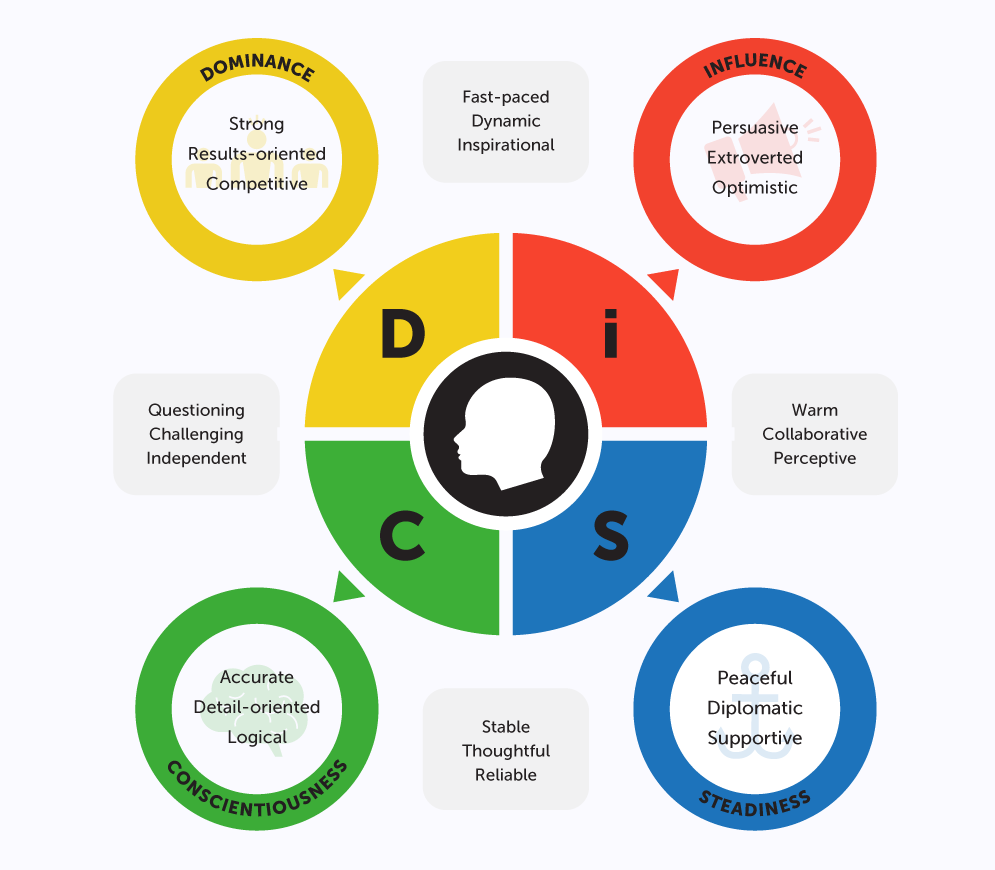
Marston’s DISC system begins with four personality traits: Dominance (D), Influence (I), Consistency (S) and Compliance (C). When taking the DISC test, you can define your personality group by 1 or 2 of the traits that suit you best. You can also be more specific by identifying which traits are most evident in your behavior through the following 12 personality group combinations:
-
Challenger (DC):
This type of person doesn’t like to cause trouble. People with this combination are motivated, get things done, and assertive – although they are also sometimes seen as emotionless, apathetic or aloof. That’s because they feel most comfortable in a dominant position, leading a team, or being an influential voice.
-
Winner (D):
This is exactly the challenger’s cousin. They are the dominant type, the one who makes the decisions right from the start – always focused, inspiring, can be a great leader and those who demand results rather than spending time on tasks. daily work.
-
Seeker (DI):
Seekers are pioneers. They are happy to take the hard road to success if it means creating more profitable processes and ideas. They feel frustrated when they rest on their victories and will push their colleagues to come up with new ideas at work.
-
Risk Acceptor (ID):
Risk-takers, too, are full of new ideas and bold leaps forward. They are less likely to seek a position of power, which means they will explore those ideas among their ranks at a basic level.
-
Enthusiast (I):
This is the type of person that everyone loves – someone who is more interested in actual entities than in their inner thoughts or feelings, aka the extravert type. They have contagious passion and can renew mental energy in an exhausting boardroom.
-
Friend (IS):
On the other hand, this type of person is always ready to listen and empathize with his colleagues. Their enthusiasm manifests through emotional and professional support for others. They are confident, aware and approachable, and work at the social center of the team.
-
Contributors (SI):
The Collaborator brings people together. Their empathy and listening skills make them ideal for bringing together teams and work units to work well together.
-
Mediator (S):
If you’re on the Consistency score of the DISC compass, you can be trusted to bring your teammates together and bridge the gap between management and the workforce.
-
Technician (SC):
Technicians are not necessarily tech-savvy, although they are very logical and understand the business operations of the business itself.
-
Platformer (CS):
This is a reliable type of person who avoids conflict but does not shirk responsibility.
-
Analyst (C):
If you are an Analyst, it is easy to be seduced by the details. You may find yourself forgetting all about time and your surroundings on the road to perfection!
-
Perfectionists (CD):
Perfectionists are detail-oriented and very assertive, a powerful combination but hard to tolerate either.
How to read a DISC . chart
3 types of DISC . charts
DISC test takers will receive a set of three results charts. Each of these graphs depicts a particular aspect of the test takers.
The three graphs of the DISC test show levels of four different characteristics of a person, including Dominance (D), Influence (I), Consistency (S), and Compliance (C). . The four points on the chart are connected by lines to establish a certain “shape” for a personality type.
The three charts may be nearly identical or significantly different, depending on the particular individual involved. Different DISC systems use different titles for these three charts, and their order may also vary from system to system. However, the meaning of each chart type remains the same.
Internal chart
This chart depicts a person’s “inside” personality and how they present themselves when they are comfortable (when in the comfort zone). This chart can also show when a person feels pressured, when they themselves are limited.
External chart
Very few people have a consistent way of expressing themselves in a variety of situations, instead, they adapt themselves to the environment in each specific situation or according to the requirements of others. External diagrams show the behavior that individuals exhibit to fit their current circumstances. So this chart can change over time, according to a person’s environment or affected by major events such as job change, house move, etc.
Summary chart
While internal and external charts provide valuable information about a person’s attitudes and perceptions, in reality, a person’s behavior is rarely based entirely on either of these two approaches. . The summary chart therefore aggregates the information from the two graphs above to give a view of the actual behavior that a person will perform.
How to read a DISC . chart
Before looking at the charts, read your Natural Style chart on the right hand side first. This chart depicts your natural tendency to behave under stress-free conditions. To read this chart, start with the red bar “D” on the left and end with the blue bar “C” on the right.
Each color bar has a meaning that is briefly described. Scores above 50 are considered high in behavioral style. Scores below 50 are low.
Whether your score is high or low shows how strongly you display that trait. If the score is in the middle, it means your style in that category tends to be moderate. Without an exact score, your personal style is a unique blend of D, I, S and C.

- The red bar D stands for Dominion. A high D tends to be direct, strong, challenge-oriented, and bold. A low D tends to be non-confrontational, non-exciting, cooperative, and agreeable. The emotion associated with a high D is anger. Hillary Clinton and Donald Trump are celebrities with high D scores.
- The yellow bar I stands for Influence. High I scores tend to be enthusiastic, persuasive, eloquent, and trusting. Low I scores tend to be reflective, cynical, grounded, and factual. The emotion associated with a high I score is optimism. Bill Clinton and Oprah Winfrey are high I scorers.
- The green bar S stands for Consistent. High S scores tend to be stable, patient, predictable, and calm. Low S scores tend to change direction, be flexible, restless, and impatient. The emotion associated with a high S score is apathy – they don’t easily express their emotions. Famous high S scores are Mother Teresa and Gandhi.
- The blue bar C stands for Compliance. A high C tends to be analytical, cautious, precise, and detail-oriented. A low C tends to be independent, unsystematic, stubborn, unconcerned with details and following the rules. The emotion associated with a high C is fear. The famous highs are Al Gore and Hermione in the Harry Potter series.
Native vs Adaptive charts
Natural style is on the right and describes how you express natural trends. Adaptive style is on the left and describes how you adjusted to your current circumstances. If you see a big difference between your natural and adaptive scores, it indicates that you may be experiencing stress from this adaptation. If you fall into this category, the best way is to ask yourself: What is the source of this stress? How can you reduce this stress?
Let’s say in the case of a student, you have to follow certain rules and regulations in order to graduate. As a result, many students adapt their C (Compliance) grades higher in the classroom.
Sometimes, in order to achieve the desired results, we must be adaptable and flexible to specific circumstances.
The importance of DISC in work and life
DISC application at work
In the recruitment competition

The DISC test is widely used in recruitment. Using the DISC test allows companies to better understand an individual’s personality and strengths/weaknesses, especially how they will respond to challenges, work in groups, solve problems from which to select candidates for suitable positions.
Not only beneficial to employers, the DISC chart is also information that managers should grasp. DISC helps managers have a clearer and more objective view of their employees as well as understand the strengths and weaknesses of each individual. It is also for this reason that banking institutions often rely on DISC to understand the performance of individuals in their particular jobs.
The DISC chart also helps managers devise strategies for working in their teams to bring about the highest working efficiency, whether working alone or in groups.
In human resource management
Many businesses and organizations use DISC as a tool in creating a positive work environment. For example, one dental office used DISC as a prominent method to make each team work more efficiently. The manager can thus track an individual’s progress and performance, what drives the individual’s growth (as well as what puts him under pressure). They have a shared and non-judgmental vocabulary to discuss issues and better perspectives of the workplace culture they desire. An office can have a separate space (Workplace) or a classic profile (Classic Profile). If they are really committed to growing the business, they can all take on the Work of Leaders.

Another example is from a construction company. Whenever a new person is hired, the employee is asked to make a profile. Profiles are shared and orientation and training are accelerated. New bookkeepers may learn that bosses are Influential (I) and tend to judge people by their openness, social skills, and enthusiasm. And the boss may know that the new accountant belongs to the Conformer (C) category and is more concerned with objective and accurate processes. Together they will identify that each of these characteristics is essential, bringing flexibility and depth to the organization. Each person will have insights into how they want to adapt their working style directly to each other.
A real estate company determines that its intermediaries need training to be effective in selling. They use DISC to help their intermediaries and administrative staff learn how to read their customers’ buying patterns. They learn to adapt their own selling styles to address customer relationship needs or responses to a request or pressure.
Job advancement is also often a reason an organization chooses to use DISC. Being a new manager or managing a new team can be quite an overwhelming experience, and DISC can help you quickly learn about your own management style.
In managing and promoting personal capacity
An example of a possible outcome for the
Low DISC chart for Domination: the type of person who would want someone else to solve the problem and take action. This individual will be cautious, indirect, patient, a good listener – very good qualities.
High on Influence: the type who wants to be around people, establishes relationships quickly and is outgoing. Since they are more focused on people, detailed results and tasks may suffer. You can see why people who rank high on Influence work great with people at work. If you’re a central figure in your career, you’ll likely be delighted with the outcome. Once you have your DISC results, you can turn them to your advantage by taking a portion of the results and putting them on your resume. This will highlight the specific strengths you have and promote your ability to work to your advantage.
DISC application in life
Related Articles
» Buying and selling businesses.
» Setting up a business with super preferential packages
In communication

A powerful tool in a competitive recruiting environment
Useful things you can apply when communicating with the four typical DISC personality groups
Communicating with the high D group
- Don’t ram or waste their time.
- Keep doing your duty
- Be clear, specific, and straight to the point.
- Don’t try to build personal relationships or make small talk.
- Be prepared with all the goals and requirements in an organized manner.
- Present the problem logically; Plan your presentation effectively.
- Provide options and alternatives so they can make their own decisions.
- If you disagree with their opinion, focus on the facts, not criticizing their character.
Communicating with a group with a high I score
- Talk and ask about their ideas and goals.
- Plan their interactions and support their goals and ideas.
- Make time for bonding and socializing.
- Don’t turn to facts, figures and alternatives.
- Help them become organized and detailed in the text.
- Don’t make them choose.
- Provide ideas for implementation.
- Provide testimonials from people they see as important or prominent.
- Encourage their willingness to take risks.
Communicating with a group with a high S score
- Do not rush into business or plans hastily.
- Show genuine interest in them like everyone else.
- Attract their personal goals and fast-tracks.
- Don’t force them to respond quickly.
- Present your case in a logical, non-threatening or verbose manner.
- Dispel the atmosphere of confusion with personal questions.
- Ask specific questions (How?)
- Do not interrupt when they speak, listen carefully.
- Pay attention to their personal feelings if the situation has a significant impact.
Communicating with a group with a high C
- Be frank and direct.
- Be aware that they may not be comfortable communicating in a large group.
- Ask them if they notice the same problem as you.
- Give them the information and time they need to make a decision.
- Don’t be too formal, sketchy, or too personal.
- Build credibility by looking at every aspect of the problem.
- Don’t force them to make a quick decision.
- Be clear about expectations and deadlines.
- If you disagree with them, prove it with data and facts or testimonials from reliable sources.
Conclude
Although DISC is not simple, it brings many benefits in recruitment and human resource management. In particular, individuals can apply useful information from the DISC chart to their own actual working environment to improve work efficiency.
Through reading the personality of colleagues, partners, associates, individuals can provide appropriate and flexible behavior and communication so that their process and goals at work achieve a smoothly and conveniently.
Are you wondering what kind of person you are in the DISC?. Contact MVA Vietnam now and we will send you the DISC test that many people are looking for. A variety of tests to assess exactly what type of person you are in DISK so that you can take advantage of your strengths and change your weaknesses. Accompanied by understanding the personality of the people around to make reasonable decisions when interacting with them to achieve the best effect.
MVA Vietnam – Success Comes From Difference












